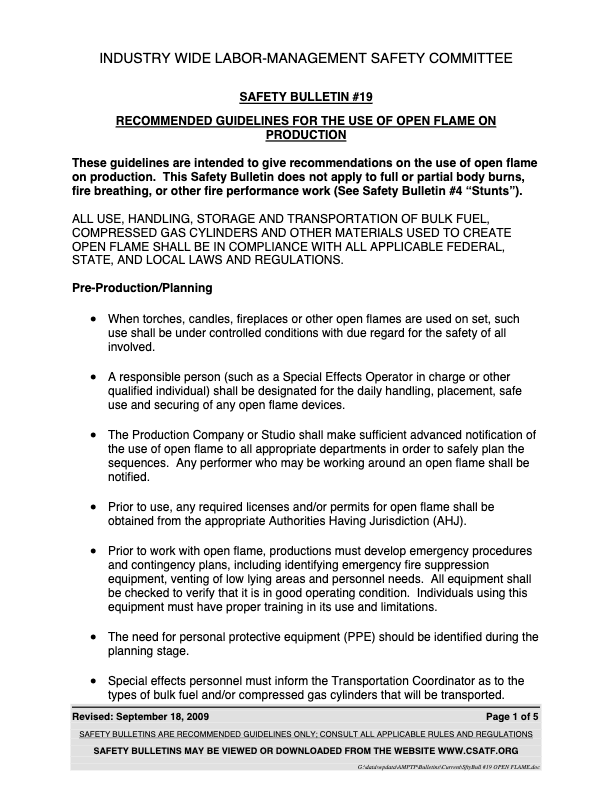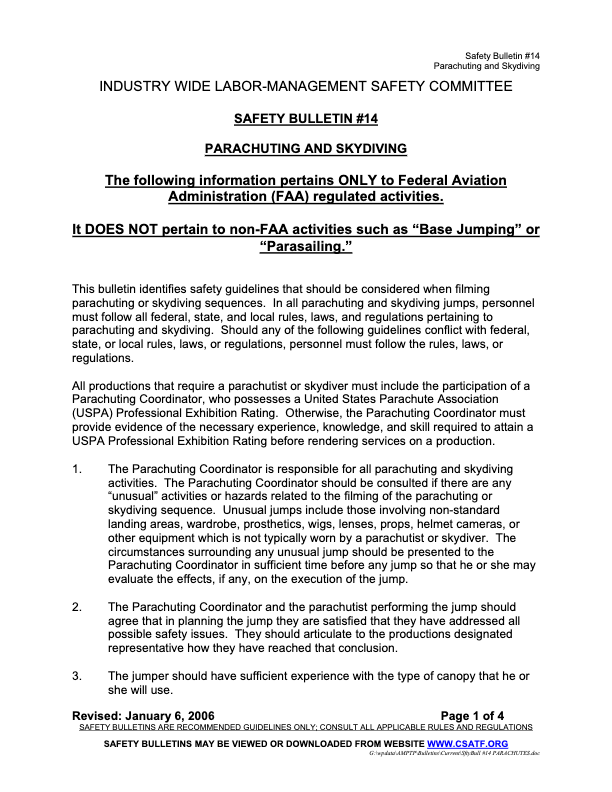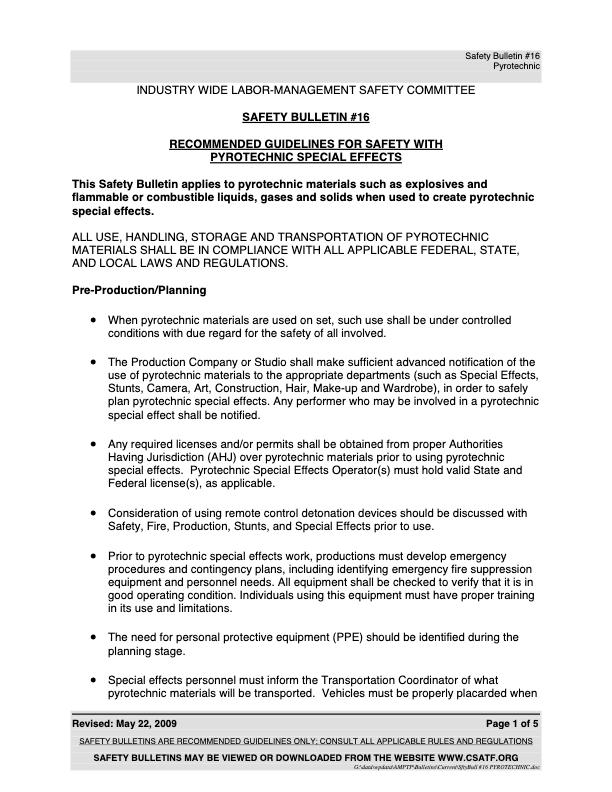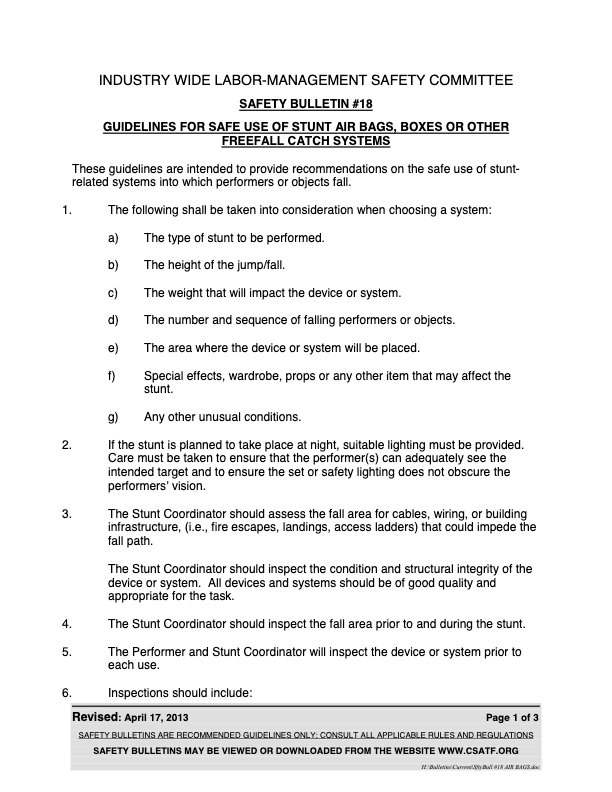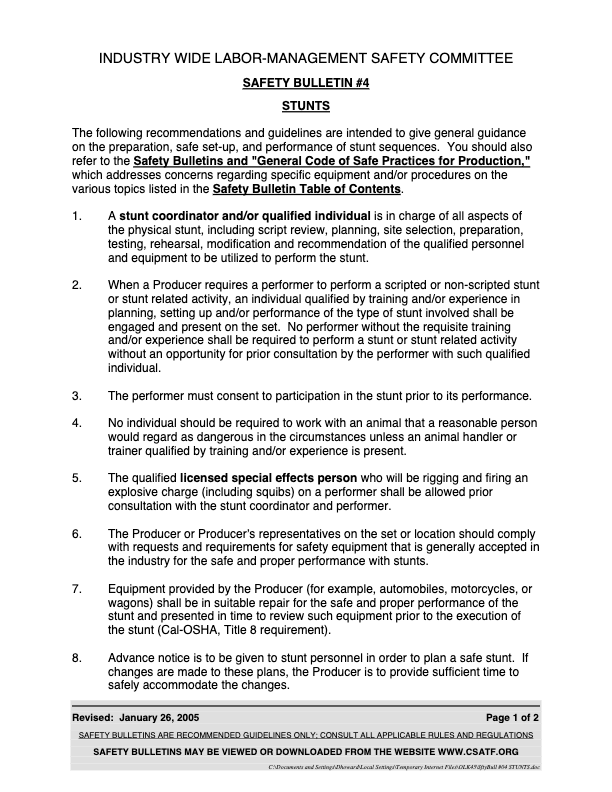Overview
All stunts and special effects must be reviewed by all participants and must be approved by faculty prior to execution to help ensure that they are performed in the safest manner possible. It is the Producer’s responsibility to make sure that the faculty has fully approved any such activities prior to the start of shooting, and any production plans that involve stunts or special effects must be described in detail at the show’s Director’s Prep. This includes, but is not limited to:
- any form of running, jumping, climbing, balancing, or falling actions that are required of actors or stunt personnel;
- any fight scenes;
- any use of real or prop weapons;
- any use of edged or piercing props;
- any scenes involving the driving of vehicles;
- any operation of potentially dangerous equipment;
- any scenes involving animals;
- any use of pyrotechnics, explosives, squibs, or fire;
- any scenes involving potential water hazards;
- any scenes involving potentially hazardous materials.
Stunt coordination
A qualified stunt coordinator must be in charge of all aspects of a physical stunt, including script review, planning, site selection, preparation, testing, rehearsal, modification, and recommendation of the qualified personnel and equipment to be utilized to perform the stunt.
When a Producer requires a performer to perform a stunt or stunt-related activity, an individual qualified by training and/or experience in planning, setting up, and/or performance of the type of stunt involved must be engaged and present on the set. No performer without the requisite training and/or experience shall be required to perform a stunt or stunt-related activity without an opportunity for prior consultation by the performer with such qualified individual. A performer must consent to participation in the stunt prior to its performance.
Advance notice is to be given to stunt personnel in order to plan a safe stunt. If changes are made to these plans, the Producer is to provide sufficient time to safely accommodate the changes and obtain faculty approval for the changes.
An on-site safety meeting, including all participants and others involved, must precede the performance of all stunts. This meeting must be documented and must include a “walk-through” or “dry-run” with the stunt coordinator and/or effects people. An understanding of the intended action, possible deviations, and authority to abort should be made clear. Before rolling cameras, should any substantive change become necessary, the First Assistant Director will again call all persons involved in the stunt to another meeting to confirm everyone’s understanding and agreement to said change(s), and faculty approval must again be obtained.
Under no circumstances should a stunt or special effect be improvised on set without prior faculty approval. Failing to adhere to this policy may result in immediate dismissal from the College of the Producer and any other students deemed responsible for the violation.
Appropriate Personal Protection Equipment (PPE) and/or other safety equipment must be provided to the cast and crew as needed. Wardrobe, hair, and make-up should be presented in sufficient time to determine if such items will impact the execution of the stunt. Final safety approval rests with the stunt coordinator and/or qualified individual.
The stunt coordinator and/or qualified individual shall determine whether safety requires the exclusion of non-essential crew from the stunt area. Perimeter control should be established and maintained. Traffic control procedures shall be reviewed, and special attention should be paid to driving sequences where unauthorized personnel could enter the area. The stunt coordinator and/or qualified individual should be involved in safe placement of cameras, camera operators and all essential crew. There must be a planned escape route and each person involved should personally check all escape routes.
Pyrotechnics, explosives, and fire
Special effects involving pyrotechnics, explosives and/or fire must be noted in advance on the call sheet. Properly licensed individuals must perform all such effects. The necessary permits must be obtained and the appropriate regulatory agencies notified. Explosives must be stored and disposed of properly.
Radios, cell phones, personal electronic devices, transmitting equipment, and remote control equipment should not be used around pyrotechnic or other explosive devices.

